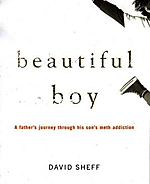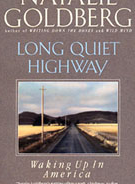Beautiful Boy by David Sheff
A journalist’s memoir of his son’s addiction 2008 My favorite thing about David Sheff’s book is his ability to hold two entirely different thoughts in the same paragraph—even in the same sentence. There’s nothing to be done, we have to do everything we can do. We have done everything we can do, we have more to do. Vicki and I agonize over it. Paradox is at the center of this book. And agony. The catalyst for this paradox? Nic, the author’s son, a kind of golden boy—bright, privileged, a surfer, a gifted writer, who, as a young teenager begins trying drugs and who, by his late teens, is trapped in a horrific and destructive addiction to crystal meth. This can be agonizing to watch, even as a reader. Especially agonizing when the bursts of recovery don’t last—when Nic relapses. Again. And again. (I have this memory, years ago, working with addicts, sitting at a meeting, after one of the best and brightest, a young man a full year sober—he’d just relapsed. I remember his friend standing to speak, saying how easy it would be to be furious at him. But then he remembered—his own relapses—how long it took—how long the process took. And he recited one of those lines that people in recovery sometimes use: It takes what it takes. That line has always stuck with me. Recovery as a process. Not just getting sober once. But again—and again—and again. It takes what it takes, even if part of what it takes is another relapse.) Beautiful Boy is about recovery as a process. Not just one treatment facility but several. For this particular family, insurance and other resources allowed them to make repeated treatment a reality. And it’s hard, while reading, not to think of all the families in similar situations who are without such resources for recovery. But that, I think, is another book. In this book, David Sheff, a skilled journalist and an eminently readable writer, is able to give us a feel of the process, his process, as it is happening. In the middle of it. How many times have I promised myself never to do this again, never again live in a state of panic, waiting for Nic to show up or not show up, to check himself in. Doing the same thing repeatedly and expecting different results is the definition of insanity. I will not do it again. I am doing it again. It’s this kind of immediacy that makes the book powerful. And I see this book as good company for any parent who has ever agonized over how much to help when an older child is in trouble. Or for any person who has ever been called an enabler, and who has said now, hey, wait a minute, what’s the difference between enabling and helping, how do you know? And when do you know? Isn’t it sometimes, well, kind of complicated? This book is, among other things, about such complications. Can it be of use to the next person in some kind of similar situation? Maybe. A little. In the introduction, Sheff writes: Why does it help to read others’ stories? It’s not only that misery loves company, because (I learned) misery is too self-absorbed to want much company. Others’ experiences did...
read more




